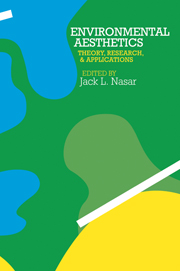Book contents
- Frontmatter
- Contents
- List of figures
- List of tables
- List of contributors and participants
- Acknowledgments
- Preface
- Section I Theory
- Section II Empirical studies
- Editor's introduction
- A Methodological comments
- B Architectural interiors
- C Architectural exteriors
- D Urban scenes
- E Natural and rural scenes
- Editor's introduction
- 22 Dimensions of meaning in the perception of natural settings and their relationship to aesthetic response
- 23 A cognitive analysis of preference for field-and-forest environments
- 24 The emotional quality of scenes and observation points: a look at prospect and refuge
- 25 Aesthetic preference for rural landscapes: some resident and visitor differences
- 26 Familiarity and preference: a cross-cultural analysis
- Section III Applications
- References
- Index of authors
- Subject index
Editor's introduction
Published online by Cambridge University Press: 05 September 2013
- Frontmatter
- Contents
- List of figures
- List of tables
- List of contributors and participants
- Acknowledgments
- Preface
- Section I Theory
- Section II Empirical studies
- Editor's introduction
- A Methodological comments
- B Architectural interiors
- C Architectural exteriors
- D Urban scenes
- E Natural and rural scenes
- Editor's introduction
- 22 Dimensions of meaning in the perception of natural settings and their relationship to aesthetic response
- 23 A cognitive analysis of preference for field-and-forest environments
- 24 The emotional quality of scenes and observation points: a look at prospect and refuge
- 25 Aesthetic preference for rural landscapes: some resident and visitor differences
- 26 Familiarity and preference: a cross-cultural analysis
- Section III Applications
- References
- Index of authors
- Subject index
Summary
The studies in this section examine the perception of and preference for natural and rural scenes. As in the previous section, this section does not include a paper aimed at deriving dimensions of affect for such scenes, but I briefly describe Craik's (1966) Landscape Adjective checklist (a comprehensive list of adjectives for assessing the landscape).
Craik first had 35 students describe each of 50 landscapes. From the 1,196 descriptors used, he culled those adjectives that were used most frequently (at least 6 times). The resulting list is shown in Table II.2. I have divided the list into adjectives that refer primarily to affective state and adjectives that refer primarily to scene features. Of course, such a division is not always clear. For example, adjectives such as active, lonely, lifeless, cool, and cold could refer to a subjective state or to a scene property.
The list can be used to obtain a comprehensive assessment of a landscape or to develop a shorter list of descriptors for a particular purpose. For example, one study in this section (Nasar, Julian, Buchman, Humphreys, and Mrohaly) used this list to develop a shorter list of descriptors. As with urban scenes, three factors – liking, excitement, and safety – emerged.
- Type
- Chapter
- Information
- Environmental AestheticsTheory, Research, and Application, pp. 323 - 326Publisher: Cambridge University PressPrint publication year: 1988



